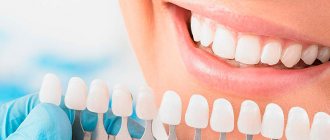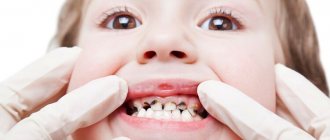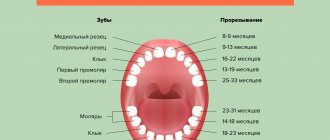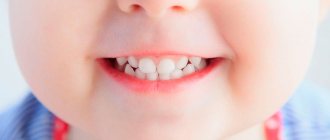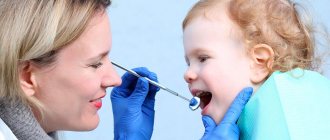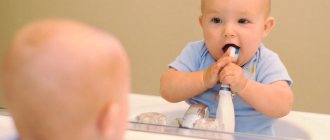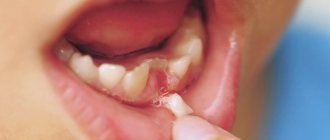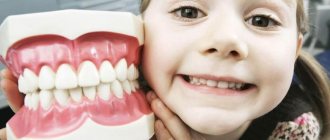05.11.2019
Plaque cannot be called a major problem - it is not a carious lesion and does not have pulpitis. It does not cause pain or significant tooth decay, but it causes aesthetic discomfort. Moms and dads worry whether plaque in their child is the first sign of oral disease. Do you need to fight and how to do it: on your own or with the help of a dentist?
Why do children's teeth change color?
The change in enamel shade is due to various reasons:
- failure to comply with hygiene rules;
- excess sweet food;
- lack of solid foods in the diet;
- heredity (in fact, there is no plaque, but pigmentation is present - the baby’s teeth become dark, like those of the mother or father);
- fluorosis (a disease in which, due to a lack of fluoride, the enamel becomes covered with light and dark spots, depressions, dots, and pits are noticeable);
- enamel hypoplasia (thin tissue of the crown, as a result of which plaque quickly accumulates, penetrates deep into the dentin, and caries develops).
The reasons are basically the same as in adult patients. But there are additional ones: for example, dark, and especially black, plaque can be caused by the presence in the oral cavity of bacteria that are not causative agents of caries and do not cause harm - this is Priestley’s plaque. Adults also have such bacteria, but they do not cause the formation of dental plaque.
Dysbacteriosis is a possible cause of darkening of tooth enamel. If your child is prescribed antibiotics, after finishing the treatment, make sure that the little patient takes a course of probiotics that restore the intestinal microflora.
Low hemoglobin causes the prescription of medications containing iron. If a child sucks or chews such tablets, after a while the parents will notice a brown coating on the baby’s teeth.
Treatment of caries of primary teeth –
Treatment of caries in children under 3 years of age differs from treatment in older children. The choice of technique will primarily depend on 1) the age of the child and his behavior in the doctor’s chair, 2) the depth of the carious lesion, 3) as well as the behavior of the child’s parents. Typical inadequate demands of parents are “not to paint your teeth black”, “not to give an anesthetic injection”, “not to drill your teeth”, etc. All this makes it difficult to choose the optimal treatment method for a particular child.
1) Treatment of caries in children under 3 years of age –
In children of this age (depending on the depth of the carious process, as well as on behavior in the dentist’s chair), the following treatment methods can be used:
- remineralizing therapy,
- silvering (Fig. 11),
- deep fluoridation (Fig. 12),
- gentle filling of teeth (Fig. 13).
The method of tooth remineralization - remineralization of tooth enamel (saturation of it with calcium and phosphates) is carried out for the initial and superficial forms of caries of primary teeth. The course ranges from 5 to 10 procedures. As therapeutic agents, drugs such as, for example, calcium phosphate gel “GC Tooth Mousse” containing the complex “CPP-ACP” (casein-phospho-peptide-amorphous calcium phosphate) are used. An example of another product is “ROCS-mineral” based on calcium glycerophosphate and xylitol.
All these products can be used not only in the dentist’s office, but also at home. The main requirements are regular oral hygiene and a complete absence of plaque (plus the exclusion of the consumption of easily digestible carbohydrates, including sugary drinks). Treatment will not be effective if these requirements are not met. The drug “GC Tooth Mousse” will be more effective; it is easy to buy online and easy to use at home.
Deep fluoridation method (Fig. 12) - this method is also carried out in the presence of initial caries in the white spot stage, as well as in superficial caries. It is best to apply it in the second stage, i.e. immediately after the remineralization course. In total, a fluoridation course consists of 3-5 procedures, which consist of applying preparations based on sodium fluoride, tin fluoride, amino fluoride (optimally in the form of a varnish, which after application hardens on the enamel surface) to the surface of the tooth enamel.
The effectiveness of the fluoridation process greatly depends on the composition of the product used. It is important to choose an effective and at the same time safe concentration of fluoride for the child. You can read more about optimal medications at the link above. In addition, there is the drug “Enamel-sealing liquid Tiefenfluorid” (Germany), which is two-component and allows you to combine both remineralization and fluoridation at once.
Teeth silvering method (Fig. 11) - this method is used to treat initial caries in the white spot stage, superficial and medium caries. The silvering method is used only for the treatment of baby teeth, because... it causes areas of the tooth affected by caries to turn black. It is usually indicated in children no older than 3 years, because After 3-3.5 years of age, in most cases it is already possible to agree with the child on the traditional option of dental treatment (here, everything basically depends on the ability and desire of the dentist to find an approach to the child).
Of course, it is not entirely optimal to use it for the treatment of foci of demineralization in the form of white spots, as well as superficial caries, because Ideally, in these cases, it is advisable to conduct courses of remineralization and fluoridation. But with average caries (circular and planar forms), this method is not so bad, because In some children, it may be the only opportunity to survive until the physiological change of teeth, i.e. will allow you to do without their premature removal.
The optimal drug is Saforide (based on 38% silver diaminofluoride). According to the recommendations of the Russian Dental Association, silvering of teeth should be carried out not just once, but from 3 to 5 times. Only in this case is it possible to achieve stabilization of the process, but further maintenance repeated courses will be necessary, the period between which can be 1-3-6 months. The duration between repeated courses will depend on a number of factors, for example, the level of oral hygiene, the rate of caries progression, etc.
Gentle filling of teeth in children under 3 years of age - this method is carried out for superficial and medium caries. Don’t worry, filling teeth in children of this age is quite possible, and many dentists treat even 1.5-year-old children in this way. The most important thing here is the approach, and that the child is not scared from the very beginning. For example, it is very important not to cause any unpleasant sensations to the child during 1 visit, and therefore the child first only has his teeth brushed with polishing brushes and a tasty paste, and enamel strengthening agents are also applied to the teeth.
On the second visit, you can begin gentle filling. First, it is necessary to remove the sharp edges of the enamel and softened dentin. This can be done not only with a drill, but also with the help of scraping with hand tools specially designed for this. This is possible because the enamel and dentin in children of this age are much softer than in adults. It is also very important that in young children pain sensitivity in the teeth is reduced, and usually everything is painless.
There is another way to facilitate the removal of enamel and dentin affected by caries. This method involves first applying a special gel (for example, Carisolv, Switzerland), which softens tissues affected by caries and does not affect healthy enamel and dentin. After this, all that remains is to carry out very light scraping with hand tools. Nevertheless, it must be recognized that in some cases, high-quality filling can be carried out only after preparing the carious cavity with a drill, and in this case, only small carious cavities can be cured without anesthesia.
Important points that parents need to know before getting a filling -
- It is very important that the dentist has a “caries marker” drug, which helps the dentist determine whether he has completely removed the dentin affected by caries. In children of this age, this can be very difficult to determine. If the dentist leaves even a little bit of carious dentin, caries will occur under the filling, which will very quickly turn into pulpitis and acute pain. Those. If the doctor doesn’t have such a drug initially, I wouldn’t even sign up for treatment if I were you.
- Selection of material for filling - after removing all tissues affected by caries and appropriate antiseptic treatment, the actual filling begins. The second important point is the choice of filling material. Children of this age can and should have their teeth filled only with “glass ionomer cements” (GIC), for example, “Ketak-molar”, “Ionofil”, “Fuji IX”, “Cemion”, etc. In addition, even with average caries in children, a therapeutic pad made of calcium-containing material is always placed under such a filling.
2) Treatment of caries in children from 3 to 6 years old –
If your child has an initial form of caries (in the form of white chalky spots), then the treatment will be the same as for children under 3 years of age - remineralizing therapy, deep fluoridation, and in the worst case - silvering. We provided a link to these methods just above. For superficial, medium and deep caries in children of this age, it is optimal to use the technique of filling teeth with glass ionomer cements (GIC).
Before filling, carious tissues should preferably be drilled out with a drill, and only as a last resort can scraping of carious tissues with curettage spoons or smoothers be used. Under the glass ionomer filling (if the caries is medium or deep), a spacer made of calcium-containing material must also be placed.
Only if the child is emotionally unbalanced, is very afraid of the sound of the drill, in children who do not allow anesthesia or have a contraindication for it, in children with diseases of the central nervous system, it is preferable to use not a drill, but alternative methods of removing tissue affected by caries. It is also worth considering that if we are talking about a child’s very first visit to the dentist, then no invasive procedures should be performed during this visit (you should limit yourself to only polishing the teeth and applying fluoride varnish). This will allow the child to have a more positive attitude towards the dentist in the future.
Before brown plaque: first stage
Formation takes place in 3 stages:
- white coating;
- yellow and brown deposits;
- tartar.
What is visible to the naked eye on a child’s teeth, despite the fact that the color of the deposits is light or whitish, is normal daily plaque, consisting of the remains of bacterial activity and food residues.
Light plaque is easy to remove: make sure your child brushes his teeth every day, morning and evening, before bed. Control the quality of brushing: the child can honestly squeeze toothpaste onto the brush, but instead of the required 2-3 minutes of movements over all surfaces of the teeth, simply swipe the front teeth left and right several times. As a result, most of the bacteria remain in place.
If you notice white deposits on your child’s teeth, you don’t need treatment from a dentist: you just have to tell your child every day and don’t forget to clearly demonstrate by example how to brush your teeth correctly. Then do a morning and evening cleansing session together. When a child remembers and understands the rules, he will get rid of plaque every day and avoid the danger of caries.
Causes of occurrence in children 1-2 years old
Even the smallest children, for example, one year old and generally up to 2 years old, often have a problem such as the appearance of plaque of various colors on the teeth.
A child’s smile can be influenced not only by external factors (for example, in the form of poor nutrition or poor personal hygiene), problems can arise even during the prenatal period, due to poor nutrition of the mother, bad habits and many other factors that are not dental _
The baby's tooth enamel is formed in the second trimester of pregnancy. During this period, the expectant mother needs to eat properly and fully and lead a healthy lifestyle, since she is responsible not only for herself, but also for the health of the child. If you adhere to a balanced and proper diet, the body will be saturated with essential vitamins and minerals , which is an important condition for the child to develop fully and correctly in the womb.
On baby teeth
Among the main reasons why plaque may appear on a child’s baby teeth are the following:
- During pregnancy, the woman ate poorly or incorrectly and ate foods high in iron, fluorine and calcium. When teeth appear, a child may immediately develop plaque or stains on the enamel.
- While carrying the child, the expectant mother took medications that negatively affected the formation of strong, healthy tooth enamel.
- Viral diseases suffered by a pregnant woman.
- Smoking and drinking alcohol during pregnancy. Such bad habits can lead not only to bad teeth in the future, but also to serious pathologies in the child’s body.
- Negligence in maintaining personal hygiene rules. A child’s teeth should be brushed when the first baby teeth erupt, using a soft brush or a silicone pad on the finger.
- Malnutrition of a child. A large amount of sweet, unhealthy and starchy foods, and a shortage of fresh vegetables and fruits.
On permanent basis
Plaque on teeth can appear not only on baby teeth, but also on permanent teeth, and in large quantities, and it is much more difficult to get rid of.
The reasons for the appearance of plaque on enamel can be:
- Weakening of the child's body's defenses and weak immunity. Due to these reasons, the child’s body cannot cope with harmful microorganisms and cannot prevent their reproduction, which is why a layer of plaque forms on the enamel.
- Plaque on permanent teeth can be black, brown or purple. The cause of such changes may be the use of medications with high iron content.
- Treatment with drugs with an antibacterial effect for a long time.
- Low humidity level in the room where the child is. Due to dry air, the natural process of salivation is disrupted, with the help of which harmful bacteria and food debris are “washed out”.
- Baby teeth are more prone to the formation of plaque and dark spots on the enamel, but if the plaque is not removed and this problem is not treated, all problems will transfer to permanent teeth as soon as they appear.
- Poor nutrition, abuse of junk food and irregular or poor quality dental cleaning.
Before brown plaque: second stage
When your baby's teeth become yellow, you may need to consult a dentist. This is not caries yet. However, the formation of yellow deposits indicates that the environment in the mouth has begun to change towards oxidation. The yellow coating is also soft and can sometimes be removed with a brush and floss.
If you can’t clean your child’s teeth with these simple home remedies, contact your dentist. He will use a paste to coat the baby's baby teeth. But the effect lasts for about six months. From now on, parents’ task becomes constant monitoring of cleaning.
Yellow plaque appears in children who refuse to use a mug and continue to drink milk and bottled water.
Give your child - if he is old enough - solid foods, they help to cleanse the teeth themselves.
Plaque turns brown
This is evidence of sediment mineralization. Most likely, they became hard and turned into tartar.
The stone is formed from the inside, but can also be found on the outside. You cannot deal with it on your own: the dentist is working to remove such plaque.
If you see not only dark plaque on your baby’s teeth, but also small irregularities, dots, and shading, it is likely that the child has fluorosis.
It is caused by excess fluoride. They are treated with specially selected fluoride-free pastes and drinking water passed through a filter. Only a doctor can make a diagnosis.
Brown plaque in infants
Your baby has not yet switched to foods from the adult table, but has he already developed a brown coating? Causes:
- sweet additives in the diet;
- night feedings;
- illnesses the mother suffered during pregnancy.
Caries can develop even before the baby's first year has passed if you offer him a lot of sweet drinks and purees.
Night feedings are another reason. At night, saliva is produced in smaller quantities, so if a child drinks milk, the teeth are not so intensively washed with salivary fluid and are not cleaned. Bacteria settle on them, causing gradual darkening and hardening of the deposits. The result is caries.
If a woman suffered severe toxicosis or was ill while carrying a child, her body felt a lack of essential vitamins and microelements. Therefore, the laying of the baby’s first teeth occurred “with errors”: the milk teeth, growing, quickly became affected by caries.
Special diet
It is believed that apples and raw carrots are the best teeth cleaners. These products perfectly remove plaque and supply a huge amount of useful substances to the body. Therefore, you should not limit yourself to them.
The LeaderStom network of clinics offers the services of the best pediatric dentists in Moscow. If you seek professional help in time, the condition of your child’s teeth can be correctly corrected with a course of treatment or preventive measures. Experienced therapists and orthopedists will help eliminate pathological yellowness of teeth and straighten your baby’s bite if indicated. Contact us, we are always ready to help.
Plaque on baby and permanent teeth: is there a difference?
Plaque appears on any teeth. There are no particular differences. But dentists note different attitudes of parents towards plaque: if it is noticeable on baby teeth, they may ignore it, especially if the child does not complain. The motivation is as follows: since the teeth are unstable, there is no need to waste time and money on treatment.
But if you treat the problem this way, there is a high risk of:
- gingivitis;
- stomatitis;
- pharyngitis;
- laryngitis;
- laryngotracheitis.
To prevent their occurrence, remove plaque on time. In addition, if the baby teeth were in a neglected state, then the molars could also grow sick.
Types and features
Plaque of various colors can form on a child’s teeth; let’s look at the main variants of plaque.
White
White and light yellow plaque can appear in any child, and this will not be a sign of disease or the formation of tartar. Such plaque can be deposited due to poor brushing of teeth and during sleep, since at this time bacteria actively multiply in the oral cavity.
Yellow
Yellow plaque appears due to poor cleaning of teeth and mouth. It can be easily removed by thoroughly brushing your teeth with a regular toothbrush and toothpaste. Another reason for yellow plaque is drinking water with a high fluoride content. Such plaque cannot be removed on your own, as it is a deep violation of the enamel structure.
Green
Green plaque – destruction of the protective layer of enamel, active proliferation of harmful bacteria. Another reason is hormonal disorders in the child’s body. If you notice such a plaque on a child, do not try to remove it yourself, it is impossible. Visit your pediatric dentist as soon as possible.
Grey
Gray plaque is one of the most dangerous types of plaque , which can destroy teeth in a short time. It “erases” the surface protective layer of enamel, makes teeth rough, provokes an unpleasant odor and the rapid spread of carious processes. In this case, you need to consult a dentist and follow all recommendations in order to save your teeth. Most often, the doctor prescribes remineralizing procedures.
Brown
Brown plaque is a consequence of poor oral hygiene. Another reason is an incorrectly selected brush and paste.
Black
Black coating. The main reason for its appearance is drugs with a high iron content, which are prescribed orally to a child to treat anemia. This plaque can be removed using a toothbrush with a little baking soda.
To prevent black plaque from appearing, give your child such medications through a straw, then thoroughly brush your teeth and rinse your mouth.
Plaque accompanied by dental caries
If caries has already appeared on plaque-laden teeth, parents will notice the following signs:
- the teeth become uneven, the surface, if you run your finger over it, becomes rough;
- enamel with caries loses its shine and becomes dull;
- upon examination it is clear: the darkening affected only the outer side; if there is a carious cavity, it is noticeable that the tooth is damaged from the inside.
It's hard to look at all of this on your own. Without experience and special knowledge, it is easy to make mistakes. Contact your dentist.
For clarity, we will present a table - it will be easier for you to understand what changes are happening to your teeth.
| Signs | Raid | Caries |
| Color | Whitish, yellow, brown, black | Most often noticeable by brown spots and stripes |
| Surface | Rovnaya | Rough, rough |
| Condition of adjacent teeth | Plaque usually covers several teeth - the entire upper or entire lower row | Caries most often develops on one tooth. Neighboring ones are either unchanged or covered with plaque |
| Child's feelings | None | Pain may occur when eating cold and hot food, or getting cold air into the cavities. |
Plaque and tartar
Essentially, these are 2 stages of one process. You can figure out whether there are hard deposits on your teeth by looking at the plate below:
| Signs | Raid | Tartar |
| Color | Any: from white to black. Comes with a greenish tint | Color from dark yellow to dark brown |
| Location | On any surface | More often, where it is difficult to clean your teeth well: on the inside of the front teeth, in the spaces between teeth, close to the gums. More often seen with crowded teeth |
| What cleaning methods does it lend itself to? | Clean with a brush with paste or homemade bleaching products, such as lemon | Can't remove it at home |
If you see plaque on your baby that cannot be removed with a brush, it’s time to visit a doctor.
Whitening pastes
Such pastes and gels can be freely purchased in pharmacies, or ordered on the recommendation of your doctor. It is not advisable to use them constantly, since they still have some effect on the enamel. It is best to periodically alternate whitening compounds with medicinal or gum strengthening ones.
With your dentist's approval, you can try home whitening using trays and whitening gels. Such procedures can significantly change the tone of tooth enamel towards white. However, you should not get carried away with this method, since it increases tooth sensitivity and, if used incorrectly, can damage tooth enamel.
Is it possible to remove plaque at home?
Try to cope with the help of traditional medicine recipes. But at the same time, you must be 100 percent sure that the child does not have carious lesions, otherwise severe pain will arise, and you will have to run to the dentist immediately, abandoning everything.
Methods that are relatively safe for children's teeth are as follows.
Activated carbon
Take a tablet of activated carbon, crush it to a powdery state, add a couple of drops of water with a pipette and apply the mixture to the brush. Let the child brush his teeth with the product, then rinse his mouth and use hygiene paste.
If the plaque disappears, it means there are no carious cavities yet. In the future, maintain good hygiene.
Lemon
Cut a piece of lemon and press the slice to the child’s teeth, you can rub it lightly. The soft coating is removed. But the baby may not like the specific taste of lemon.
Strawberry puree
Mash fresh strawberries to a puree and apply with your finger to the child’s teeth. Thanks to the presence of fruit acids, the berry copes with plaque. But she can’t handle a hard coating.
You can use strawberries instead of strawberries.
How to get rid of it
You won’t be able to get rid of black plaque on children’s teeth at home on your own. The use of aggressive products or methods can cause serious damage to the enamel. To restore the color of teeth, it is necessary to determine the exact cause of the pathology.
If the blackening of teeth is not associated with dental diseases, then treatment is carried out comprehensively. The dentist performs all manipulations to clean the enamel, and another specialist deals with the main disease.
If the cause is unknown or the disease is chronic, the child’s teeth may periodically darken again. Unlike ordinary yellow or brown plaque, black deposits create a pronounced aesthetic defect, so it cannot be done without the help of a dentist.
Products that improve enamel color
To help prevent darkening of your teeth:
- nuts (contain vitamins necessary for the proper formation of enamel);
- apples and pears (contain fruit acids and water);
- strawberries, wild strawberries (have whitening properties);
- broccoli (removes dark colored deposits).
As soon as the child's teeth have formed, he must be gradually introduced to solid food. Let him nibble on carrots and green apples: in addition to saturating the body with vitamins, they help clean off soft deposits.
Give your child more dairy products. But sweets should be limited: they create an excellent breeding ground for bacteria.
Is yellowness normal or pathological?
Not every yellowness should be perceived as a deviation from the norm. Sometimes, due to hereditary factors, a child’s enamel becomes more transparent than that of other children. The lack of white pigment causes the dentin to show through, resulting in darker teeth.
Some dentists are inclined to believe that it is better not to correct or whiten such enamel. At least until the child reaches adulthood and hard tissues are fully formed.
If yellow teeth are showing signs of health, the best thing you can do for your baby is to practice good oral hygiene and good nutrition.
When to start brushing your child's teeth
Caring for the oral cavity of a newborn means periodic examination. But as soon as the first tooth appears, brush it. The baby's first brush is a special fingertip for the mother, one side of which is covered with soft short bristles. Put it on and massage your teeth. This should not cause any discomfort to the baby.
Dr. Komarovsky advises starting full-fledged care from the age of one and a half years. He names the main reasons for the transformation of enamel shade in children:
- metabolic disease;
- lack of calcium and vitamin D;
- indoor air is too dry;
- insufficient functions of saliva.
A dental examination of baby teeth is mandatory. The doctor will find the root of the problem and tell you how to eliminate the cause of the formation.
Advice from Dr. Zubastik
Have you discovered that your baby’s teeth are covered with plaque? Try cleaning them first or watch your child do this procedure. If deposits remain, make an appointment with your dentist. He will take action: he will explain what to add to your diet when caring for your teeth so that the enamel does not change shade, and, if necessary, he will perform silver plating or put a filling.
For certain indications, a child over 10 years old is allowed to have their teeth brushed. This procedure may be necessary in your case.
Keep an eye on your child’s teeth – this is an indicator of the general state of the immune system. Are they white and strong? Congratulations, your young heir can boast of excellent health!
Prevention
To prevent the formation of plaque and deposits on teeth, follow these simple rules:
- Do not give your child fast food, fatty, spicy, sweet and junk foods, as well as sugary carbonated drinks. There is still no benefit to them, but the harm is colossal, and not only for the teeth.
- From an early age, teach your child to brush their teeth responsibly. Ideally, after each meal, you should rinse your mouth to remove any remaining food.
- Teach your child to eat a balanced, healthy diet. With a minimum amount of unhealthy food and a maximum amount of healthy food. Include fresh fruits and vegetables in your daily diet.
In the article, we tried to reveal as much as possible the answers to all questions about plaque that interest parents. Remember that the best way to eliminate and treat plaque is its prevention and compliance with personal hygiene rules.
